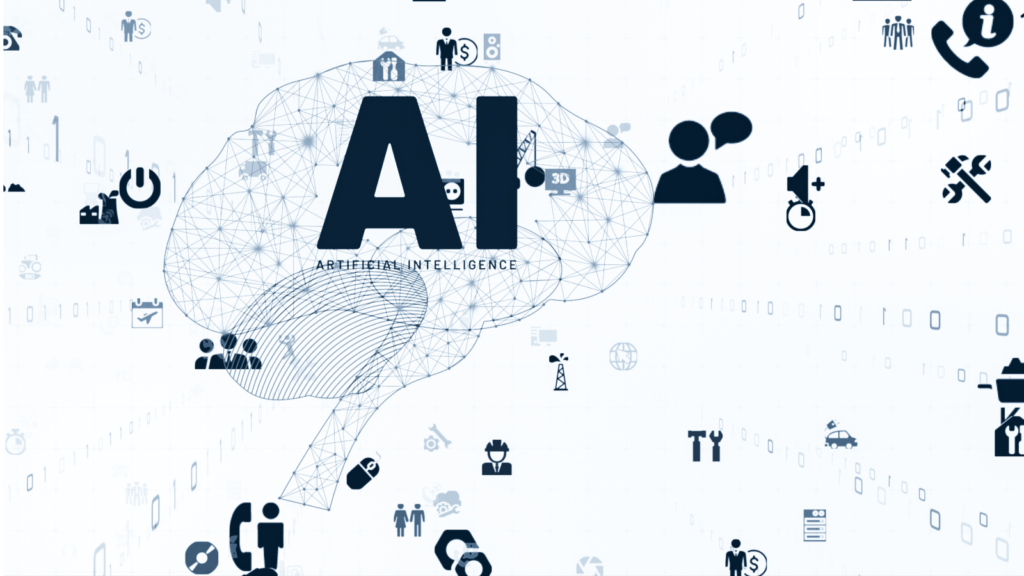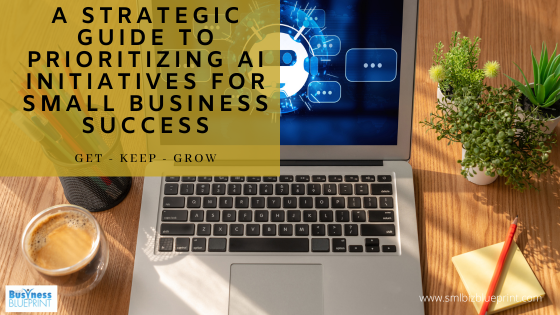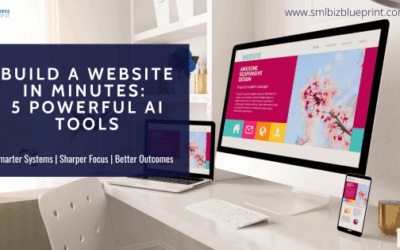Artificial Intelligence (AI) has emerged as a beacon of innovation, driving efficiency and competitive advantage.
This guide illuminates the path for business leaders and decision-makers, from assessing AI projects’ potential return on investment (ROI) to crafting a winning AI strategy that resonates with their business goals.
As we embark on this insightful journey, we’ll explore the critical steps of AI project prioritisation, balancing the scales between impact and feasibility and laying a robust foundation for successful AI implementation.
We’ll explore the nuances of scaling AI solutions for future growth and the pivotal role of measuring success through precise KPIs and metrics.
Whether you’re leading a burgeoning startup or an established enterprise, this blog post will guide you through the dynamic seas of AI initiatives, ensuring that every decision propels your business towards unparalleled success and innovation.
Join us as we unlock the steps to strategically prioritising AI initiatives that align with your business challenges and pave the way for a future replete with possibilities.

#1 Understanding the ROI of AI: Navigating Your Way to Profitable Projects
In an era where technology transcends traditional business boundaries, understanding the Return on Investment (ROI) of Artificial Intelligence (AI) initiatives becomes beneficial and essential for businesses aiming to thrive.
The ROI of AI transcends mere financial metrics, embodying the promise of efficiency gains, enhanced customer satisfaction, and a relentless push towards innovation.
The Essence of AI ROI
At its core, AI ROI is about quantifying the value AI brings to your business in concrete terms. It’s a measure that goes beyond the initial cost savings, encompassing the broader impact on your operational efficiency, customer experiences, and even product or service innovation.
For instance, an AI-powered customer service chatbot can provide 24/7 support, reducing response times and operational costs and significantly enhancing customer satisfaction.
Evaluating AI’s Potential
To effectively assess the potential ROI of AI initiatives, businesses must first establish clear, measurable objectives. Consider the specific goals you aim to achieve with AI, be it increasing sales, improving customer engagement, or streamlining operations.
For example, a retail company implementing AI for inventory management might aim for a 25% reduction in stockouts and a 15% decrease in excess inventory.
The next step involves a comprehensive analysis of current performance metrics against projected outcomes post-AI implementation.
Tools and methodologies such as predictive analytics and cost-benefit analysis play a pivotal role here, helping to forecast potential returns and providing a clear comparison against existing benchmarks.
Key Takeaways
Understanding and evaluating the ROI of AI initiatives requires a strategic approach that considers both AI’s tangible and intangible benefits.
By setting clear objectives, meticulously analyzing potential outcomes, and learning from the industry’s success stories, businesses can navigate to profitable AI projects that boost the bottom line and drive innovation and customer satisfaction.
Embracing AI is not just about adopting new technology; it’s about strategically investing in initiatives that promise the highest returns, ensuring every step taken is a calculated stride towards achieving overarching business objectives.
In the next section, we’ll delve into crafting a winning AI strategy that aligns seamlessly with your business goals, laying the groundwork for a future where AI is not just an option but a fundamental component of business success.
#2 Crafting a Winning AI Strategy: Aligning Projects with Business Goals
Embarking on AI initiatives without a cohesive strategy is akin to setting sail without a compass; you might move forward, but the chances of reaching your desired destination are left to the whims of the sea.
A winning AI strategy is your navigational chart, ensuring every initiative propels you closer to your business objectives, whether enhancing operational efficiency, improving customer engagement, or pioneering new product innovations.
The Imperative of Strategic Alignment
Strategic alignment is the cornerstone of a successful AI implementation. It ensures that every AI project is a step towards fulfilling your business’s long-term vision.
This alignment is particularly crucial in today’s fast-paced business environment.
Setting the Sails: Identifying Your Business Objectives
The journey begins with a clear articulation of your business goals. Are you looking to use AI to cut costs, enhance customer service, or innovate your product offerings?
For example, a financial services firm might prioritise AI to improve fraud detection, enhance security, and increase customer trust.
Setting measurable, time-bound objectives allows you to anchor your AI initiatives in tangible outcomes. Employing tools like SMART (Specific, Measurable, Achievable, Relevant, Time-bound) criteria can be instrumental in this phase, ensuring your goals are well-defined and attainable.
Navigating Industry-Specific Waters
The application of AI is not one-size-fits-all; it varies significantly across different industries. In healthcare, AI might be pivotal in predictive diagnostics, while in retail, personalised shopping experiences could be the focus.
Understanding the unique challenges and opportunities within your industry is crucial. For instance, an AI-driven predictive maintenance system can revolutionise manufacturing operations by reducing downtime and maintenance costs, showcasing how industry-specific applications of AI can yield substantial ROI.
The Collective Voyage: Involving Stakeholders
A winning AI strategy is not crafted in isolation; it requires the collective insight of various stakeholders across the organisation. Involving a diverse group, from the tech team to customer service representatives, ensures that the strategy is robust, inclusive, and attuned to the multifaceted aspects of the business.
This collaborative approach enriches the strategy and fosters a sense of ownership and alignment across the organisation.
Key Takeaways
Crafting a winning AI strategy is a deliberate and thoughtful process that demands a deep understanding of your business goals, industry-specific challenges, and stakeholders’ diverse perspectives.
It’s about aligning your AI initiatives with your business’s core objectives, ensuring that every technological advancement you embrace is a step towards your goals.
As we progress to the next section, we’ll explore the nuanced art of prioritising AI projects, balancing their potential impact against their feasibility, and strategically selecting the initiatives that promise the greatest value to your business in pursuing your objectives.

#3 The Art of AI Project Prioritization: Balancing Impact with Feasibility
In Artificial Intelligence (AI), the abundance of opportunities often leads to a critical juncture: which initiatives to pursue first?
This is where the art of prioritization comes into play. It balances AI projects’ potential impact and feasibility, ensuring that resources are allocated to ventures that align closely with your strategic goals and offer tangible benefits.
Setting the Stage: Prioritization Criteria
The first step in this delicate balancing act involves establishing clear prioritisation criteria.
Consider factors such as the project’s strategic importance, potential to enhance customer experience, contribution to operational efficiency, and level of innovation.
For example, an AI initiative aimed at personalising customer interactions might rank high in terms of customer experience and strategic importance, particularly for businesses in sectors like retail or hospitality.
Navigating Through Decision-Making Frameworks
Employing a structured decision-making framework with criteria in place can greatly simplify the prioritisation process. Tools such as weighted scoring models allow you to assign scores to each project based on the established criteria, offering a quantifiable means to compare diverse initiatives.
This approach ensures that decisions are grounded in objective analysis rather than intuition, guiding you towards projects with the highest potential for impact.
Sailing Together: The Role of Stakeholder Engagement
Prioritisation is not a solitary journey; it requires the collective wisdom of various organisational stakeholders. Engaging cross-functional teams in the prioritisation process brings multiple perspectives and ensures that the selected AI initiatives have broad-based support.
Techniques like collaborative workshops and stakeholder surveys can be invaluable in garnering insights and fostering a sense of ownership among team members, making the voyage towards AI integration a united effort.
Key Takeaways
Prioritising AI projects is a critical step in ensuring that your investments in AI yield the desired outcomes.
By establishing clear criteria, utilising decision-making frameworks, and fostering stakeholder engagement, businesses can rapidly navigate the complex landscape of AI opportunities, focusing on initiatives that promise the greatest impact and align with their strategic objectives.
As we advance to the next section, we’ll delve into the blueprint for successful AI implementation, exploring how to transform prioritised initiatives into tangible results that drive business success.
#4 AI Implementation Blueprint: Laying the Foundations for Success
With a clear direction set and priorities established, the next pivotal step in harnessing the power of Artificial Intelligence (AI) for your business is laying down a robust blueprint for implementation.
This stage is where strategic planning transitions into actionable steps, ensuring that the chosen AI initiatives are executed efficiently, effectively, and aligned with your overarching business goals.
Charting the Course: Planning for Implementation
A well-structured implementation plan is a roadmap for your AI projects, detailing each initiative’s what, when, how, and who. This plan should outline specific milestones, timelines, and required resources, ensuring that every aspect of the project is meticulously planned.
For instance, if your business aims to integrate an AI-powered customer service chatbot, the plan would detail the development phases, the data training process, integration with existing systems, and the timeline for each phase.
Mobilizing Resources: The Backbone of AI Projects
AI initiatives’ success heavily relies on resource availability and allocation, encompassing human talent and technological infrastructure. Securing a team with the right mix of skills, including data scientists, AI developers, and project managers, is crucial.
Equally important is ensuring that the necessary technological infrastructure, such as cloud services and AI platforms, is in place. This might involve upgrading existing systems or investing in new technologies to support AI applications.
Navigating Challenges: Anticipating and Overcoming Obstacles
Every journey faces its challenges, and AI implementation is no exception. Common hurdles include data quality issues, integration complexities with existing systems, and user adoption.
Proactively addressing these challenges is key to a smooth implementation process.
For example, conducting thorough data audits and cleansing can mitigate data-related issues, while comprehensive training programs can facilitate user adoption and acceptance.
Key Takeaways
The blueprint for AI implementation is critical in translating AI strategies and priorities into actionable projects that drive real business value.
By developing a detailed implementation plan, mobilising the necessary resources, and proactively navigating potential challenges, businesses can ensure that their AI initiatives are set up for success from the outset.
In the subsequent section, we will explore how businesses can ensure the scalability and flexibility of their AI solutions, preparing them to adapt and grow in the ever-evolving landscape of AI technology and market demands.

#5 Scaling for the Future: Building Flexible and Scalable AI Solutions
As businesses evolve and grow, the AI solutions they implement must not only address current needs but also have the capacity to expand and adapt to future challenges and opportunities.
This foresight in building flexible and scalable AI solutions is paramount in maintaining the relevance and effectiveness of your AI initiatives, ensuring they continue to deliver value as your business scales.
Embracing Scalability: The Key to Long-Term Success
Scalability should be a core consideration from the very inception of any AI project. This involves selecting technologies and platforms that can handle increasing volumes of data and more complex processing as your business grows.
Cloud-based AI services, for example, offer the elasticity needed to scale up or down based on demand, ensuring that your AI capabilities can grow in tandem with your business without the need for substantial additional investments.
Flexibility in Design: Preparing for the Unknown
The only constant in the tech world is change. Designing AI solutions flexibly allows your business to adapt to new technologies, methodologies, and business requirements.
This could mean adopting modular architectures for AI systems, where components can be updated or replaced independently, or using open standards and APIs to ensure compatibility with future technologies.
Staying Ahead: The Role of Emerging Technologies
Keeping abreast of emerging AI technologies and trends is crucial for maintaining the scalability and flexibility of your AI solutions. Regularly evaluating and potentially integrating new advancements can enhance your AI capabilities and ensure your business remains at the cutting edge.
Whether adopting quantum computing for data processing or leveraging next-gen AI algorithms, staying informed lets you update your AI strategy promptly.
Key Takeaways
Building AI solutions that are both scalable and flexible is essential for businesses aiming for long-term success in today’s dynamic market landscape.
By prioritising scalability in the planning phase, designing for flexibility, and staying updated on emerging technologies, businesses can ensure their AI initiatives remain robust, relevant, and aligned with their evolving needs.
In the following section, we will delve into the critical aspect of measuring the success of AI initiatives. Understanding how to define, track, and interpret key performance indicators (KPIs) is vital for assessing the impact of your AI projects and guiding future strategies.
#6 Measuring Success: KPIs and Metrics for AI Initiatives
Measuring the success of your AI initiatives is crucial in integrating artificial intelligence (AI) into business operations. It’s not just about validating the effectiveness of these projects but also about gaining insights that can guide future strategies and investments.
Setting clear Key Performance Indicators (KPIs) and metrics is essential. They provide a quantifiable measure of your AI initiatives performing against set objectives.
Defining Success Metrics: The Compass of AI Initiatives
The first step in measuring AI success is defining success for each initiative. This involves identifying specific, measurable outcomes that align with business objectives.
For instance, if your AI project aims to enhance customer service, relevant KPIs include reduced response times, increased resolution rates, or improved customer satisfaction scores.
These metrics should be directly linked to the objectives outlined in your AI strategy, ensuring they provide a clear indication of performance.
Implementing a Data-Driven Approach
With KPIs in place, implementing a robust system for tracking and analysing these metrics is paramount. This often involves leveraging data analytics tools and platforms to collect, process, and visualise data in real-time.
By adopting a data-driven approach, businesses can gain valuable insights into the effectiveness of their AI initiatives, identifying areas of success and opportunities for improvement.
Continuous Improvement: The Iterative Nature of AI
One of AI’s inherent strengths is its capacity for learning and improvement. Regularly reviewing AI initiatives’ performance against set KPIs allows for an iterative refinement.
This could involve fine-tuning AI algorithms, adjusting data inputs, or redefining KPIs as business objectives evolve. This continuous cycle of evaluation and adjustment is key to maximising the ROI of AI initiatives and ensuring they remain aligned with business goals.
Key Takeaways
Measuring the success of AI initiatives is a critical component of any AI strategy, providing the insights needed to validate the impact of your investments and guide future decisions.
By defining clear, relevant KPIs, adopting a data-driven approach to performance analysis, and embracing AI’s iterative nature, businesses can ensure their AI projects contribute meaningfully to their strategic objectives and long-term success.
In conclusion, the strategic prioritisation and implementation of AI initiatives, guided by a well-defined measurement framework, are essential for businesses looking to leverage AI for enhanced efficiency, innovation, and competitive advantage.
Conclusion
As we navigate the complex yet exhilarating landscape of Artificial Intelligence (AI) in the business realm, it’s clear that a strategic, informed approach is beneficial and essential.
From understanding the nuanced dynamics of AI ROI and crafting a bespoke AI strategy that resonates with your business goals to the artful prioritisation of AI projects and the meticulous planning of their implementation, each step is a building block towards transformative success.
We’ve explored the significance of building scalable and flexible AI solutions that can grow and evolve with your business, ensuring long-term sustainability and relevance in an ever-changing technological landscape.
Furthermore, the importance of measuring the success of your AI initiatives through clear, relevant KPIs cannot be overstated, as it provides the insights needed to continuously refine and optimise your AI strategy.
In conclusion, the journey towards integrating AI into your business is multifaceted and continuous, requiring strategic foresight, meticulous planning, and an agile approach.
As you embark on or continue this journey, remember that the key to unlocking AI’s full potential lies in prioritizing initiatives that align closely with your business objectives are feasible and scalable, and whose success can be measured and built upon.
FAQs
Q1: What is the ROI of AI in business, and how can it be measured?
A1: The ROI of AI in business encompasses not only financial returns but also improvements in operational efficiency, customer satisfaction, and innovation. It can be measured by setting specific, quantifiable goals for each AI initiative and evaluating performance against these goals using KPIs and metrics.
Q2: How do I align AI initiatives with my business objectives?
A2: Aligning AI initiatives with business objectives involves understanding your overarching business goals, identifying how AI can support these goals, and ensuring that each AI project is strategically chosen to contribute to these objectives. Involving stakeholders and ensuring cross-functional alignment are also crucial steps.
Q3: What factors should be considered when prioritising AI projects?
A3: Factors to consider include the project’s strategic importance, potential impact on customer experience or operational efficiency, required resources, and feasibility of successful implementation. Using a structured decision-making framework can help evaluate and prioritize projects.
Q4: What are the key components of a successful AI implementation plan?
A4: A successful AI implementation plan should outline specific milestones, timelines, resource allocations, and risk management strategies. It should also address potential challenges, such as data quality, system integration, and user adoption, with strategies to overcome these.
Q5: How can businesses ensure the scalability of their AI solutions?
A5: To ensure scalability, businesses should opt for flexible and modular AI technologies and platforms that can grow with their needs. Emphasising cloud-based solutions and designing AI systems that can handle increasing data volumes and complexity is essential.
Q6: What role does continuous improvement play in AI initiatives?
A6: Continuous improvement is crucial in AI initiatives due to the iterative nature of AI and machine learning. Regularly reviewing and adjusting AI strategies and models based on performance metrics ensures that AI initiatives remain effective and aligned with business goals.
Q7: How can businesses stay ahead with emerging AI technologies?
A7: Staying informed about the latest AI technologies and trends is key. Businesses should consider incorporating emerging technologies to enhance their AI capabilities, ensuring they remain competitive and innovative. Regularly evaluating and integrating new advancements can enhance AI effectiveness.
Other Articles
Guide to Conquering AI Integration Challenges For Small Businesses
AI Empowerment: Tailored GPT Solutions for Small Business
Boost Business Growth: AI-Powered Email Marketing Strategies




